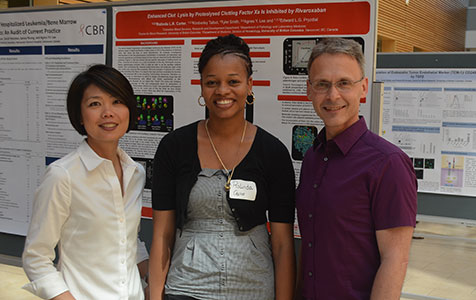![]() By Rolinda Carter, PhD Student in Pryzdial Lab, CBR
By Rolinda Carter, PhD Student in Pryzdial Lab, CBR
Every year millions of people worldwide are affected by abnormal blood clots. These clots, caused by either a reduction in blood flow, blood vessel injury, or a pre-existing condition, can, if left untreated, lead to serious complications, such as post-phlebitic syndrome, pulmonary embolus and/or chronic lung injury. Historically, physicians have used anticoagulants to prevent and treat blood clots and until recently, the only options available were heparin, an indirect inhibitor of clotting factors, and warfarin, an inhibitor of vitamin K production. While saving countless lives, their use necessitates frequent injections and regular doctor visits to monitor clotting parameters. However, treatment options are changing with the emergence of a new generation of anticoagulants referred to as direct oral anticoagulants (DOACs).
Unlike previous anticoagulants which indirectly prevent blood clot formation, DOACs bind directly to and inhibit either thrombin or factor Xa – two clotting proteins that are vital in the formation of a blood clot. Importantly, this new class of drugs is available in a pill form and does not require regular doctor office monitoring, increasing patient satisfaction. They are, however, still fairly new, with the first one being approved in Canada within the last 7 years, making ongoing translational research and clinical trials vitally important. At the Centre for Blood Research (CBR), a few principal investigators have taken up the challenge to contribute to this growing area in anticoagulant therapy.
Dr. Jayachandran Kizhakkedathu:
Neutralizing the effect of anticoagulants
The risk of bleeding associated with the use of anticoagulants makes neutralizing their effect necessary. Dr. Kizhakkedathu and his group have had tremendous success in developing a synthetic universal heparin reversal agent in a work published in 2014. He has now begun to explore new avenues in the development of synthetic oral anticoagulant neutralizing agents.
Dr. Agnes Lee:
Clinical Studies using DOACs
In addition to neutralizing the effects of DOACs, it is often necessary to stop their use to reduce the risk of bleeding during a surgery. Through the Perioperative Anticoagulant Use for Surgery Evaluation (PAUSE) study, Dr. Lee is helping to establish a protocol for interrupting the use of DOACs when an elective surgery or procedure is required. PAUSE is a CIHR/HSF funded study led by Dr. Jim Douketis at McMaster University.
Dr. Lee is also taking part in a phase II-b study (ADAM) aimed at measuring the plasma levels of a DOAC in patients with multiple myeloma who are receiving chemotherapy. The latter is important, as cancer patients are known to have an increased risk of developing a blood clot compared to non-cancer patients. It is anticipated that the ADAM study will help to determine if the DOAC tested reduces the risk of blood clots in patients with multiple myeloma.
Dr. Ed Pryzdial:
DOACs in clot dissolution (fibrinolysis)
Anticoagulants are not known to directly dissolve preformed clots. However, Dr. Pryzdial lab discovery that FXa, a DOAC target protein, can also participate in fibrinolysis, is changing the way we think about how clots are dissolved. The clot dissolving function of FXa is regulated by specific cleavages which are maintained in the presence of DOACs. The clinical implications for these studies, done in collaboration with Dr. Tyler Smith and Dr. Agnes Lee, are still under investigation and make up a large portion of my PhD thesis.
As with every new class of drugs, numerous studies are needed, even after their approval, to ensure that they are safe and effective. Thanks to investigators like those at the CBR, advances in this emerging field are taking place.




